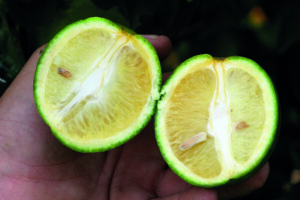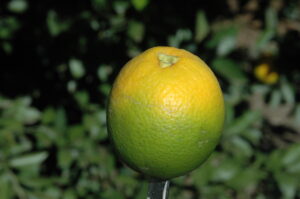PREVENTION
How can we detect it?
How can we detect it?
SYMPTOMS AND DETECTION
How can we prevent the spread of HLB?
How can we prevent the spread of HLB?
The appropriate time to look for symptoms of the presence of the vectors transmitting HLB is when there is budbreak, which covers almost the whole year (from the end of February to the beginning of May there is spring budbreak, between July and August, summer budbreak, and from September to the end of November the third budbreak or autumn budbreak).
Visual inspection would consist of selecting young shoots, looking for the presence of symptoms or the vectors themselves. The main symptoms of both psyllids are described below.
DETECTION OF
Trioza erytreae
Trioza erytreae
NIMPHS
When feeding on the leaves, the nymphs inject toxic substances which induce the formation of concave bumps on the underside of the leaf, inside which they nest individually. These nests correspond to bumps or protuberances on the upper side of the leaves.
leaves
When populations are high, the leaf and shoot may look totally deformed.
HONEYDEW
Both nymphs and adults excrete honeydew which crystallises and settles on the lower leaves, encouraging the development of black mould.
DETECTION OF
Diaphorina citri
Diaphorina citri
NIMPHS
Nymphs do not protect themselves by forming gills and are mobile in all stages.
leaves
Adults and nymphs twist young leaves and shoots and excrete copious amounts of honeydew that takes on a characteristic coiled filament shape.
HONEYDEW
Presence of whitish waxy excretions generated by both nymphs and adults.
COMMON FEATURES FOR DETECTION OF THE
HLB disease
HLB disease
fruits
The exterior of the fruit has a deformed structure that isn’t even similar to its natural shape. They are small in size and the skin is thicker. Furthermore, the colouring is neither natural nor homogeneous.
Inside, the fruit has black, aborted seeds and the stalk (the central white part) is orange in colour. In addition, there is less juice content and it is more acidic and bitter.
tree
When a tree is affected by the HLB disease, it starts to have a yellowish colouration as shown in this picture of a Florida crop field (right on the second tree).
The root system of the trees is also heavily affected by Asian HLB infections although it is not visible to the naked eye. When the tree is infected, it produces much fewer secondary roots and thus has a lot of difficulties to take up nutrients from the soil.
Over time, the tree loses nutrients and loses both leaves and fruit, which fall to the ground, lowering productivity. In as little as one year, this disease can affect an entire field and eradicate it, as happened in Florida.
One way of detecting HLB in roots is root sampling. Because roots are the only organ of the tree where there is a more or less regular distribution of the bacterium, they can be tested by PCR and, if infected, almost all of them will be positive.
DETECTION OF
Trioza erytreae
Trioza erytreae
NIMPHS
When feeding on the leaves, the nymphs inject toxic substances which induce the formation of concave bumps on the underside of the leaf, inside which they nest individually. These nests correspond to bumps or protuberances on the upper side of the leaves.
leaves
When populations are high, the leaf and shoot may look totally deformed.
HONEYDEW
Both nymphs and adults excrete honeydew which crystallises and settles on the lower leaves, encouraging the development of black mould.
DETECTION OF
Diaphorina citri
Diaphorina citri
NIMPHS
Nymphs do not protect themselves by forming gills and are mobile in all stages.
leaves
Adults and nymphs twist young leaves and shoots and excrete copious amounts of honeydew that takes on a characteristic coiled filament shape.
HONEYDEW
Presence of whitish waxy excretions generated by both nymphs and adults.
COMMON FEATURES FOR DETECTION OF THE
HLB disease
HLB disease
fruits
The exterior of the fruit has a deformed structure that isn’t even similar to its natural shape. They are small in size and the skin is thicker. Furthermore, the colouring is neither natural nor homogeneous.
Inside, the fruit has black, aborted seeds and the stalk (the central white
TREE
When a tree is affected by the HLB disease, it starts to have a yellowish colouration as shown in this picture of a Florida crop field (right on the second tree).
The root system of the trees is also heavily affected by Asian HLB infections although it is not visible to the naked eye. When the tree is infected, it produces much fewer secondary roots and thus has a lot of difficulties to take up nutrients from the soil.
Over time, the tree loses nutrients and loses both leaves and fruit, which fall to the ground, lowering productivity. In as little as one year, this disease can affect an entire field and eradicate it, as happened in Florida.
One way of detecting HLB in roots is root sampling. Because roots are the only organ of the tree where there is a more or less regular distribution of the bacterium, they can be tested by PCR and, if infected, almost all of them will be positive.
Gallery of images of
HLB symptoms
HLB symptoms
PSYLLA
How to detect its presence?
How to detect its presence?

Adhesive traps
These are yellow plastic cards with adhesive on both sides. Yellow traps are recommended over other colours. It is recommended to place them in the sprouting area of the tree, approximately 1.5 metres away.

Samples by hitting the branches
It consists of hitting a randomly selected branch three times with a PVC tube. Psyllid adults are counted as they fall onto a slat with a white sheet or a white tray placed horizontally under the branch.

Insect collection by suction
This is the use of portable, light and compact electric devices with suction capacity designed to collect insects without harming them.
















